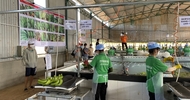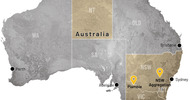Property Wire | 12 June 2013
Farm land in the UK outperforms other investments and is set to rise 5% per annum
Farm land in the UK has outperformed both equities and commodities in terms of value growth and levels of volatility over the past 17 years, with momentum continuing into the first quarter of 2013, according to a new report. Since 1995, average farm land values have risen by 9.2% per annum, well above equities at 4.1% and gilts at 7.4%, whilst returns were much less volatile at 12.4% when compared to oil at 51% and gold at 14.7%.
The Chesterton Humberts' latest rural research report says this makes farm land one of the best performing asset class in terms of low risk and high returns after gold. It is now forecasting that agricultural estate values will grow at a rate of 5% per annum over the next five years due to a combination of the longer term positive fundamentals of the sector and the supply/demand imbalance. This figure may well be exceeded in some local markets where the availability of larger estates will drive growth in values.
The firms new Agricultural Estates Index, which tracks quarterly changes in the value of a standard basket of agricultural estate types from bare land parcels up to fully equipped residential estates, average estate values rose by 0.4% in the first quarter of 2013 to stand at ң10,581 per acre. The biggest uplift was seen in the larger transactions, which are mainly driven by investors seeking opportunities to achieve worthwhile economies of scale. Overall however, farmers remain the main buyer group as they seek to expand their existing acreage, followed by UK investors and private purchasers, including overseas buyers taking advantage of the current weakness of sterling.
Despite the weather failing to improve during the first quarter of 2013, there is certainly a compelling long term case for investing in farmland,ђ said Andrew Pearce, head of Chesterton Humberts' rural agency. The main advantages, which include scarcity value, rising food demand and tax advantages, are set to continue for the foreseeable future. Additionally, the changing global weather patterns are likely to exert upwards pressure on food commodity prices, whilst technology will create longer term cost savings and efficiencies,ђ he explained.
Nick Barnes, head of research at the firm believes that provided the regulatory and tax environment stays relatively benign, it is likely to be only a matter of time before the institutional funds become more involved in the sector again. The combination of low volatility plus its potential to generate long term capital growth and income allied to potential tax benefits has demonstrated that agricultural estates outperform other assets, including equities and commodities and thus have attracted a wide range of prospective purchasers,ђ he said.
Farm land in the UK outperforms other investments and is set to rise 5% per annum
Farm land in the UK has outperformed both equities and commodities in terms of value growth and levels of volatility over the past 17 years, with momentum continuing into the first quarter of 2013, according to a new report. Since 1995, average farm land values have risen by 9.2% per annum, well above equities at 4.1% and gilts at 7.4%, whilst returns were much less volatile at 12.4% when compared to oil at 51% and gold at 14.7%.
The Chesterton Humberts' latest rural research report says this makes farm land one of the best performing asset class in terms of low risk and high returns after gold. It is now forecasting that agricultural estate values will grow at a rate of 5% per annum over the next five years due to a combination of the longer term positive fundamentals of the sector and the supply/demand imbalance. This figure may well be exceeded in some local markets where the availability of larger estates will drive growth in values.
The firms new Agricultural Estates Index, which tracks quarterly changes in the value of a standard basket of agricultural estate types from bare land parcels up to fully equipped residential estates, average estate values rose by 0.4% in the first quarter of 2013 to stand at ң10,581 per acre. The biggest uplift was seen in the larger transactions, which are mainly driven by investors seeking opportunities to achieve worthwhile economies of scale. Overall however, farmers remain the main buyer group as they seek to expand their existing acreage, followed by UK investors and private purchasers, including overseas buyers taking advantage of the current weakness of sterling.
Despite the weather failing to improve during the first quarter of 2013, there is certainly a compelling long term case for investing in farmland,ђ said Andrew Pearce, head of Chesterton Humberts' rural agency. The main advantages, which include scarcity value, rising food demand and tax advantages, are set to continue for the foreseeable future. Additionally, the changing global weather patterns are likely to exert upwards pressure on food commodity prices, whilst technology will create longer term cost savings and efficiencies,ђ he explained.
Nick Barnes, head of research at the firm believes that provided the regulatory and tax environment stays relatively benign, it is likely to be only a matter of time before the institutional funds become more involved in the sector again. The combination of low volatility plus its potential to generate long term capital growth and income allied to potential tax benefits has demonstrated that agricultural estates outperform other assets, including equities and commodities and thus have attracted a wide range of prospective purchasers,ђ he said.













